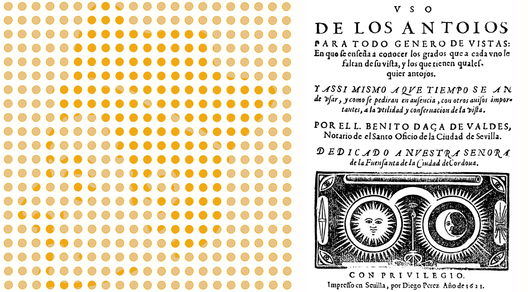Benito Daza de Valdés1591–1634
Classical considerations of visual acuity were in terms of distance or distant objects. Distinguishing double stars provided one of the earliest forms of assessing the precision of vision, and it was so applied in Egypt over 5,000 years ago. An alternative technique, introduced in the seventeenth century by Benito Daça de Valdes in 1623, involved presenting small objects of regular size and determining the distance at which they could not be discerned. For example, he measured the distance at which a row of mustard seeds could not be counted; he also varied the distance at which small print could be read. These procedures could be applied to determine the optical correction required for an individual, and he prescribed concave as well as convex lenses. These were illustrated in his book on the use of eyeglasses, the title page of which is shown; it was essentially a manual for practitioners and did not add to visual theory. Daza de Valdes is dimly portrayed in a pattern that suggests rows of mustard seeds. However, in order to recognise his profile it is the intensity of the elements rather then their number that defines him. His awe of the eye and the devises that could assist its function were expressed thus: “The invention of eyeglasses appears to have come from heaven, from where the eyes also came”. Daza de Valdes was a Dominican notary in Seville and served in the Inquisition.
